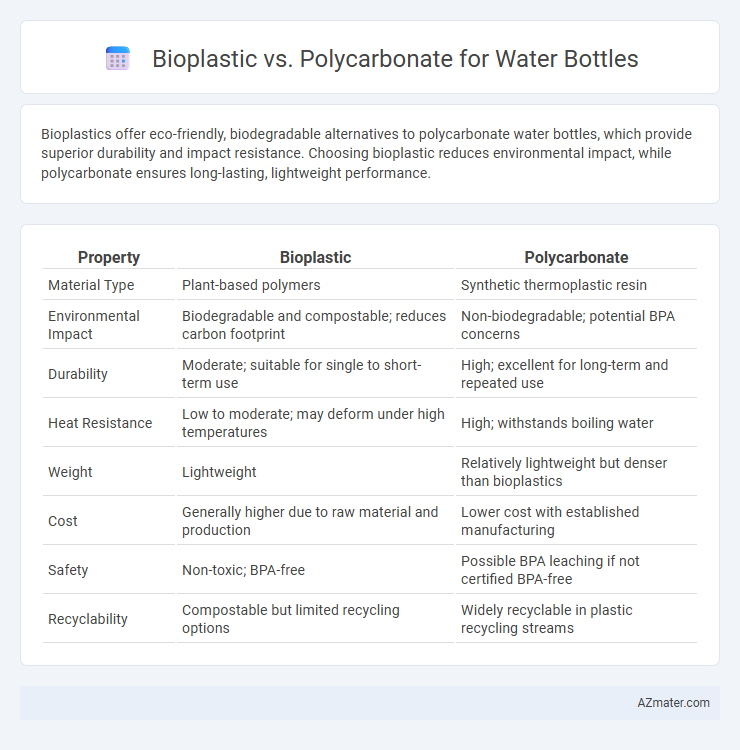Bioplastics offer eco-friendly, biodegradable alternatives to polycarbonate water bottles, which provide superior durability and impact resistance. Choosing bioplastic reduces environmental impact, while polycarbonate ensures long-lasting, lightweight performance.
Table of Comparison
| Property | Bioplastic | Polycarbonate |
|---|---|---|
| Material Type | Plant-based polymers | Synthetic thermoplastic resin |
| Environmental Impact | Biodegradable and compostable; reduces carbon footprint | Non-biodegradable; potential BPA concerns |
| Durability | Moderate; suitable for single to short-term use | High; excellent for long-term and repeated use |
| Heat Resistance | Low to moderate; may deform under high temperatures | High; withstands boiling water |
| Weight | Lightweight | Relatively lightweight but denser than bioplastics |
| Cost | Generally higher due to raw material and production | Lower cost with established manufacturing |
| Safety | Non-toxic; BPA-free | Possible BPA leaching if not certified BPA-free |
| Recyclability | Compostable but limited recycling options | Widely recyclable in plastic recycling streams |
Introduction: The Need for Sustainable Water Bottles
Bioplastic water bottles offer a renewable, biodegradable alternative to traditional polycarbonate bottles, addressing growing environmental concerns over plastic pollution and resource depletion. Polycarbonate, valued for its durability and clarity, poses health risks due to potential BPA leaching and its reliance on fossil fuels for production. Transitioning to bioplastic materials reduces carbon footprints and supports circular economy initiatives critical for sustainable water bottle manufacturing.
Understanding Bioplastic: Composition and Properties
Bioplastic water bottles are primarily composed of renewable organic materials such as cornstarch, sugarcane, or cellulose, which contribute to their biodegradability and reduced carbon footprint. These materials exhibit properties like lightweight structure, moderate durability, and resistance to cracking, but generally have lower heat resistance compared to polycarbonate. Understanding the composition of bioplastics helps in evaluating their environmental benefits and limitations in water bottle applications.
What is Polycarbonate? Key Features and Uses
Polycarbonate is a durable, lightweight thermoplastic known for its high impact resistance, transparency, and heat resistance, making it ideal for reusable water bottles. Its key features include excellent clarity, BPA-free composition, and the ability to withstand repeated cleaning without degrading. Common uses extend beyond water bottles to include eyewear lenses, medical devices, and electronic components due to its strength and safety profile.
Environmental Impact: Bioplastic vs Polycarbonate
Bioplastic water bottles typically offer a lower environmental impact than polycarbonate bottles due to their biodegradability and renewable raw materials such as cornstarch or sugarcane, reducing reliance on fossil fuels and decreasing landfill waste. Polycarbonate bottles, made from petroleum-based chemicals, pose challenges related to persistence in the environment and potential release of harmful bisphenol A (BPA) during degradation, raising concerns about ecological toxicity and human health. Lifecycle analyses show bioplastics often achieve reduced carbon footprints and improved end-of-life outcomes compared to polycarbonate alternatives, making bioplastic a more sustainable choice for eco-conscious consumers.
Health and Safety Considerations in Water Bottles
Bioplastic water bottles, derived from renewable plant-based materials, offer a safer alternative to polycarbonate bottles by avoiding BPA and other harmful chemicals linked to endocrine disruption. Polycarbonate bottles, while durable and clear, often contain bisphenol-A (BPA), raising concerns about chemical leaching into water, especially when exposed to heat or wear. Health-conscious consumers prefer bioplastic options due to their non-toxic composition, biodegradability, and reduced environmental impact in water bottle manufacturing and use.
Durability and Performance Comparison
Bioplastic water bottles offer moderate durability and biodegradability, making them suitable for short-term use but less resistant to impact and temperature variations compared to polycarbonate. Polycarbonate bottles excel in high-performance durability, providing exceptional impact resistance, clarity, and temperature tolerance, ideal for long-term and heavy-duty use. While bioplastics prioritize environmental benefits, polycarbonate materials deliver superior strength and longevity for reliable water containment.
Manufacturing Processes: Bioplastic vs Polycarbonate
Bioplastic water bottles are typically produced through renewable biomass sources such as cornstarch or sugarcane, employing processes like extrusion and injection molding that emphasize biodegradability and lower carbon emissions. Polycarbonate bottles are manufactured using petroleum-based raw materials subjected to processes including polymerization and injection molding, resulting in a durable and impact-resistant product with higher energy consumption and environmental impact. The choice between bioplastic and polycarbonate depends heavily on manufacturing sustainability goals, as bioplastics offer a more eco-friendly production cycle compared to the fossil-fuel intensive methods used for polycarbonate.
Cost Analysis and Market Availability
Bioplastic water bottles generally offer a lower upfront cost but may incur higher long-term expenses due to limited durability compared to polycarbonate alternatives. Polycarbonate bottles, despite their higher initial price, provide greater longevity and resistance to impact, justifying the investment for frequent use. Market availability of bioplastic bottles is growing in eco-conscious sectors, while polycarbonate remains widely accessible across mainstream retail and industrial supply chains.
Consumer Preferences and Trends
Bioplastic water bottles appeal to eco-conscious consumers prioritizing sustainability and biodegradability, whereas polycarbonate bottles attract buyers seeking durability and clarity. Market trends indicate increasing demand for bioplastic options due to rising environmental awareness and regulatory pressures against traditional plastics. Consumer preferences are shifting towards materials that balance environmental impact with performance, driving innovation in bioplastic formulations for water bottle production.
Future Outlook: Advancements in Water Bottle Materials
Emerging innovations in bioplastic technology emphasize increased biodegradability and reduced carbon footprints, positioning bioplastics as a sustainable alternative to traditional polycarbonate water bottles. Research in polycarbonate coatings aims to enhance durability and BPA-free safety standards, extending their lifecycle and usability in reusable bottles. The future of water bottle materials favors hybrid composites that combine bioplastics' eco-friendly properties with polycarbonate's strength and clarity for superior performance and environmental impact.

Infographic: Bioplastic vs Polycarbonate for Water bottle
 azmater.com
azmater.com